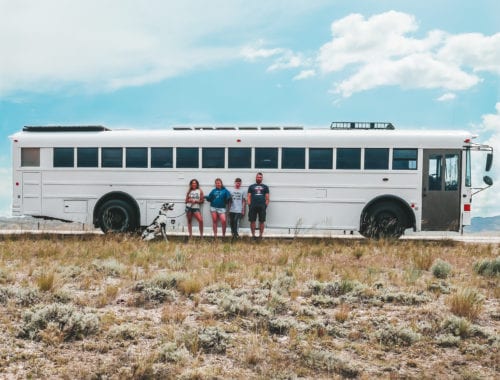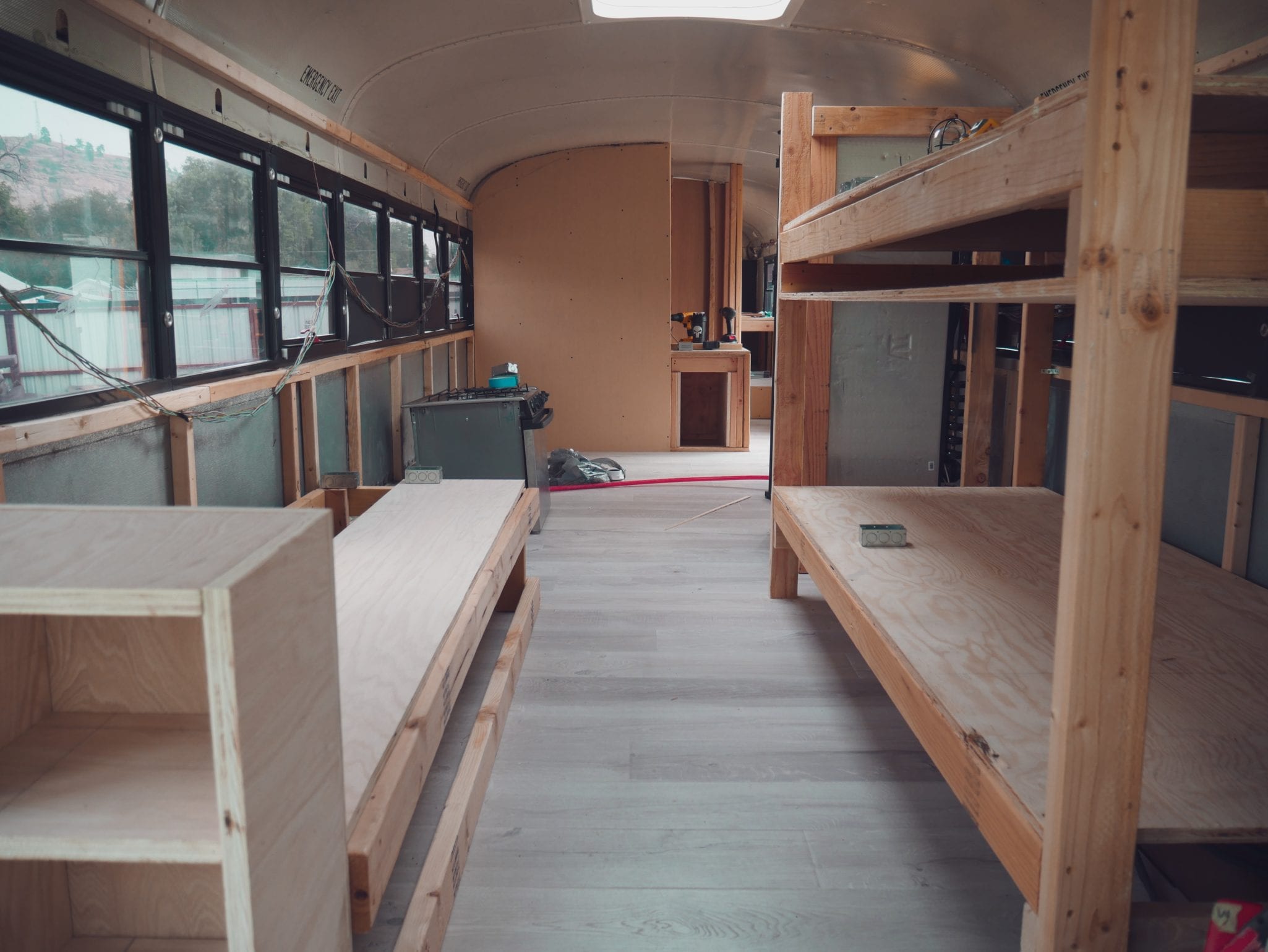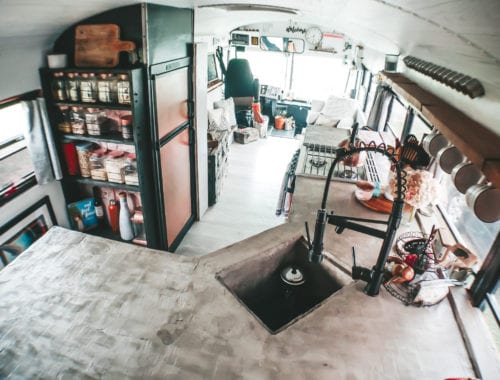Living in a Skoolie in the Winter
As we travel part-time and stay stationary for the other part, we get a lot of questions about living in a skoolie in the winter. I think it’s fair to say most bus dwellers prefer to chase the sunshine and warmer temps. But there are a number of skoolie families (like ours!) that don’t always have that option and have to hunker down in the snow.
After one full winter in the bus, I can tell you it isn’t for the faint of heart. Below zero temps, freezing winds, and feet of snow make bus life slightly harder. But it’s also possible not just to make it through the winter, but to thrive in it and enjoy a cozy holiday season in a bus.
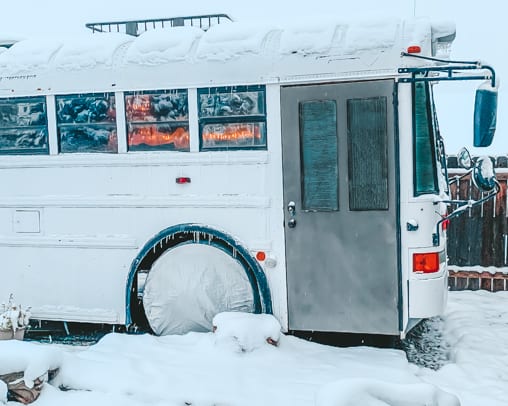
Since weathering a full Montana winter in the bus last year, we have all the tips and tricks we learned to keep toasty warm even in the coldest temps. Keep reading to learn how!
LIVING IN A SKOOLIE IN THE WINTER: CONSIDERATIONS
Winter in a regular home has few considerations – you salt the driveway to keep it ice-free, blow out your sprinklers to keep them from freezing, and keep the heater on.
Winter in a skoolie isn’t quite so simple. No matter how well you insulate, unless you’ve pulled out the majority of your windows or replaced them with energy-efficient windows, a bus won’t hold heat in like a house. This makes heating it and keeping it warm all the time more of a chore. There is no set-it-and-forget-it temperature gauge – it takes work to keep a skoolie warm.
Then there’s the matter of plumbing. Even pipes inside the bus run through the walls and floor are susceptible to freezing if the temps drop enough. This is even more important if you have pipes that run under your bus, or like us, have your water tanks in the under-storage compartment.
There’s also the bus itself to consider. Freezing and unfreezing can lead to cracking in rubber components, as we discovered when one of our side storage doors ripped off its rubber hinge in the spring. Diesel fuel can gel up in the cold, propane will change form and depressurize if the conditions are right, and a solar system covered in the snow won’t be putting out much electricity.
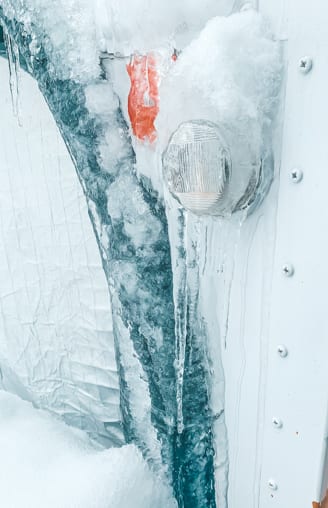
The good news is you can counteract all of this with a little preparation and some regular maintenance.
WINTER IN A SKOOLIE: A CHECKLIST
There are a few main items to consider when living in a skoolie in the winter. They are:
- How are you going to keep the bus warm?
- How can you maximize this warmth?
- How will you protect your plumbing system?
- What steps can you take to make winter easier?
Let’s break it down.
PREPARING THE BUS
An ounce of prevention is worth a pound of cure, and this is especially true when considering winter in a skoolie. Laying a proper foundation means less worry and less work later on.
- Cut down on drafts. Even well-sealed bus windows let in a TON of cold. Covering window banks with plastic will eliminate drafts and create a greenhouse effect during the day that helps heat the bus.
- Use insulated coverings. Heavy insulated curtains over the windows can further draft protection. Additionally, at the front door, we use an insulated door cover to help hold in warmth. A magnetic strip down the center allows you to pass through, but seals behind you so no warmth is lost when the door gets opened and closed.
- Insulate, insulate, insulate. Starting while you’re building, make sure that your insulation game is on point. But don’t stop there. Reflectix is a cheap and easy way to add even more insulation – like insulating our front windows using faux wall panels made out of Refelctix and thin wood.
HEATING THE BUS
When choosing a heating option, we went with a wood stove for a few reasons. Propane-fired heaters cause condensation, a nemesis of bus life. Diesel heaters are more efficient and don’t cause condensation, but we wanted to avoid natural gases altogether. Wood stoves are efficient, fuel is plentiful and mostly free, and they are a dry, radiant heat.
Our wood stove is a Jotul 602b, a little powerhouse that keeps the bus a balmy 70 even when it’s below zero.
They also come with maintenance, however. At least once a month, you’ll need to crawl up on the roof and clean the chimney of creosote buildup. You can buy a chimney brush, but we prefer to use a chain. Mike crawls onto the roof, removes the chimney cap, and then bangs the chain around inside the chimney, causing all the creosote to fall into the stove. Then I shovel it out with the ashes and voila – ready to burn.
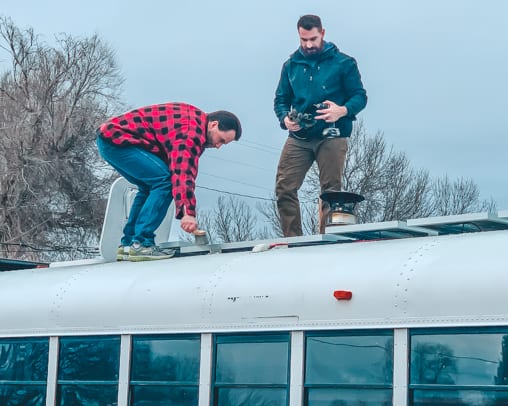
A note about wood stoves, however. Fire safety is no joke, so take every precaution you can. We personally use a smoke detector and carbon monoxide alarm and carry both a regular extinguisher and several AFG Fireballs in case a fire were to start. Especially with kids and a dog on board, safety first.
And when looking for a wood stove for your tiny space, check out this guide on small wood-burning stoves to make sure you find the right one for your home!
DEALING WITH PLUMBING
The biggest question we get asked during winter is how we keep our pipes from freezing.
The number one step you can take if you have pipes or tanks outside the bus is to insulate them. But sometimes even that isn’t enough.
If there were one thing I would change about our layout, it would be to bring our water tanks inside and locate them under the bed instead of in the “basement” of the bus. We thought we would really want/need the underbed storage, but we downsized so well we actually have plenty of room for them – and it would have saved us having to think too hard about freezing pipes and tanks.
On the coldest days, we ran a small utility heater (the kind used in barns for animals) that had an auto on/off function. When the temps dropped below freezing, it would kick on and run by the water tanks to keep them from freezing up. This brings me to my next point…
SOLAR AND ELECTRIC
Solar panels don’t work so well covered in snow. If you’re relying on them through the winter, there will be a sometimes daily job of climbing up to clean them off. And even if they’re clean, sunlight in the winter can be scarce, with as little as three hours sometimes.
We are lucky enough to have access to an RV service hookup for electricity, so instead of relying on solar through the winter, we plug in. This allows us to run the extra heater down below, all our usual appliances, and a small additional heater up front where our dog lays on the coldest nights.
DAY-TO-DAY CONSIDERATIONS
Finally, here is the advice I give people who are curious about winter in a skoolie.
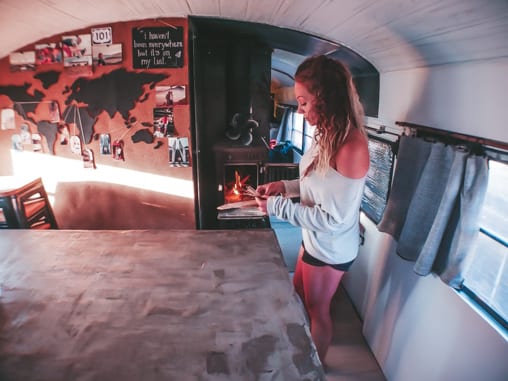
- Accessorize. Warm winter accessories that is. Instead of relying solely on your heat source, consider other ways you can add heat. Rugs on the floor help keep feet warmer. Electric blankets are a great way to supplement heat at night, and small electric heaters (if you’re plugged in) can help take the edge off.
- Pay attention to the weather. If you know what the temps are going to be ahead of time, it’s easier to plan for them. Don’t let six inches of snow and -20 degree temps sneak up on you, know when the coldest nights are expected, and plan appropriately.
- Plan ahead. Start your cold-weather planning early, in late summer/fall. Make sure everything is sealed, stored, and otherwise winter-ready before it arrives. Then stay on top of it. Plan to clean your stove and chimney on warm days when you can let your fire go out without worrying. Chop wood (or fuel up) in advance so you aren’t scrambling when the cold hits.
- Dress appropriately. This seems like a no-brainer but dress for the weather. Sleep in warm pajamas, wear slippers, and layer clothing during the day.
- Know what you’re getting into. Skoolie life comes with downsides, just like any other choice. But being mentally prepared for the hassles makes them easier to get through. For example, a wood stove needs to be fed all night. One night we slept through our set alarms and woke to a 35-degree bus. Our front door froze shut, making us use the side door all morning until it melted. Our pipes, despite insulation and heat tape and a heater, froze during a -30 night and we didn’t have water for a day. Accepting that things like this will definitely happen despite the best planning means you’ll roll with them better when they do.
LIVING IN A SKOOLIE IN THE WINTER – IT CAN BE DONE!
All this said, living in a skoolie in the winter isn’t just doable, it can be fun and downright cozy if you’re prepared! I love beach views and balmy weather, but there’s something magical about sitting in our little bus with snow drifting down outside and a roaring fire in the stove. It just takes good prep work, common-sense practices, and a little fortitude on those super-cold nights.
Have a question about bus life, our conversion, or tiny living? Lay it on us at info@sincewewokeup.com!



